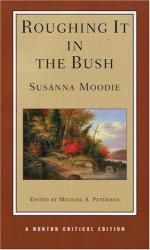The clearing process, however, in this unpromising spot, was going on vigorously. Several acres had been chopped down, and the fire had run through the prostrate trees, consuming all the smaller branches and foliage, and leaving the trunks and ground as black as charcoal could make them. Among this vast mass of ruins, four or five men were toiling with yoke of oxen. The trees were cut into manageable lengths, and were then dragged by the oxen together, so that they could be thrown up into large log-heaps to burn. The men looked, with their bare arms, hands, and faces begrimed with charcoal, more like negroes than white men; and were we, like some shallow people, to compare their apparent condition with that of the negro slaves in more favoured regions, we should be disposed to consider the latter the happier race. But this disgusting work was the work of freemen, high-spirited and energetic fellows, who feared neither man nor wild beast, and trusted to their own strong arms to conquer all difficulties, while they could discern the light of freedom and independence glimmering through the dark woods before them.
A few years afterwards, I visited C—–, and looked about for the dreadful cedar-swamp which struck such a chill into my heart, and destroyed the illusion which had possessed my mind of the beauty of the Canadian woods. The trees were gone, the tangled roots were gone, and the cedar-swamp was converted into a fair grassy meadow, as smooth as a bowling-green. About sixteen years after my first visit to this spot, I saw it again, and it was covered with stone and brick houses; and one portion of it was occupied by a large manufactory, five or six stories high, with steam-engines, spinning-jennies, and all the machinery for working up the wool of the country into every description of clothing. This is civilisation! This is freedom!
The sites of towns and villages in Canada are never selected at random. In England, a concurrence of circumstances has generally led to the gradual formation of hamlets, villages, and towns. In many instances, towns have grown up in barbarous ages around a place of refuge during war; around a fortalice or castle, and more frequently around the ford over a river, where the detention of travellers has led to the establishment of a place of entertainment, a blacksmith’s or carpenter’s shop. A village or town never grows to any size in Canada without a saw or a grist mill, both which require a certain amount of water-power to work the machinery. Whenever there is a river or stream available for such purposes, and the surrounding country is fertile, the village rapidly rises to be a considerable town. Frame-houses are so quickly erected, and the materials are so easily procured near a saw-mill, that, in the first instance, no other description of houses is to be found in our incipient towns. But as the town increases, brick and stone houses rapidly supplant these less substantial edifices, which seldom remain good for more than thirty or forty years.




